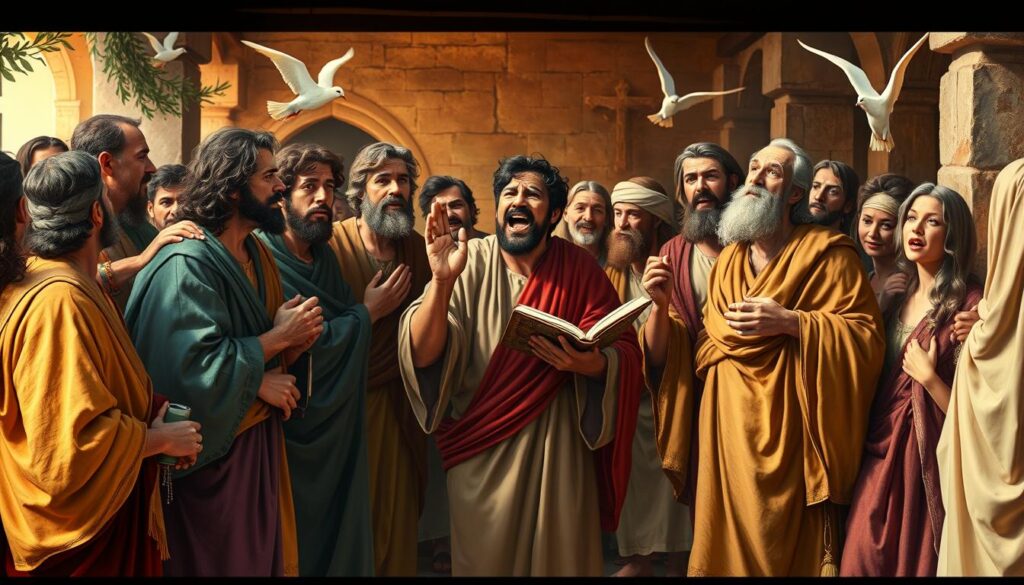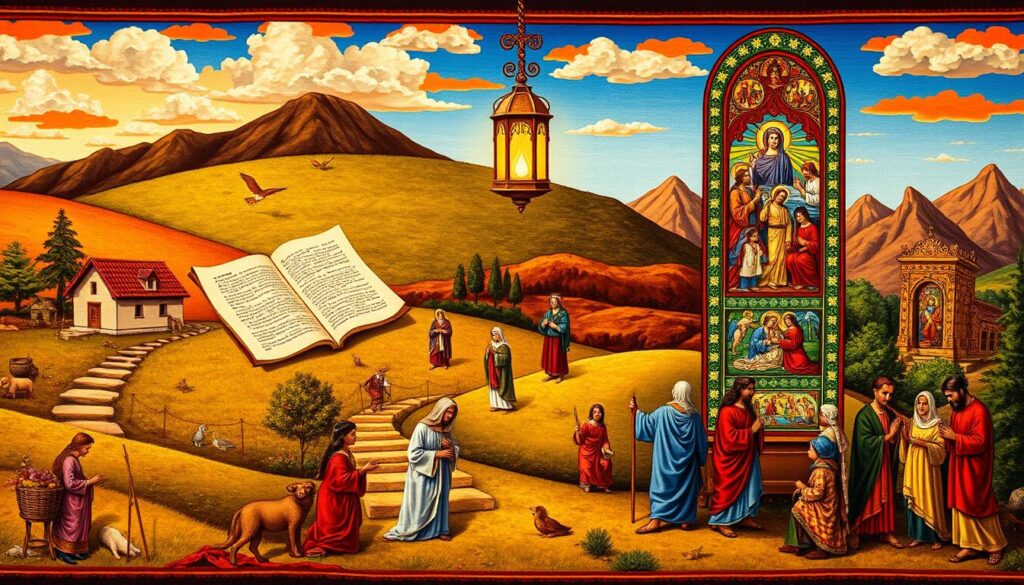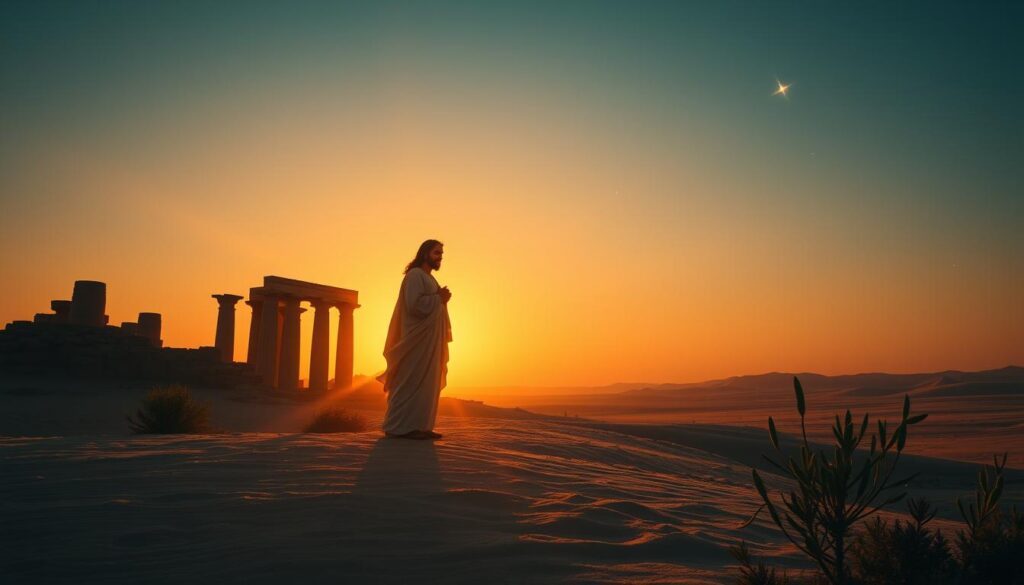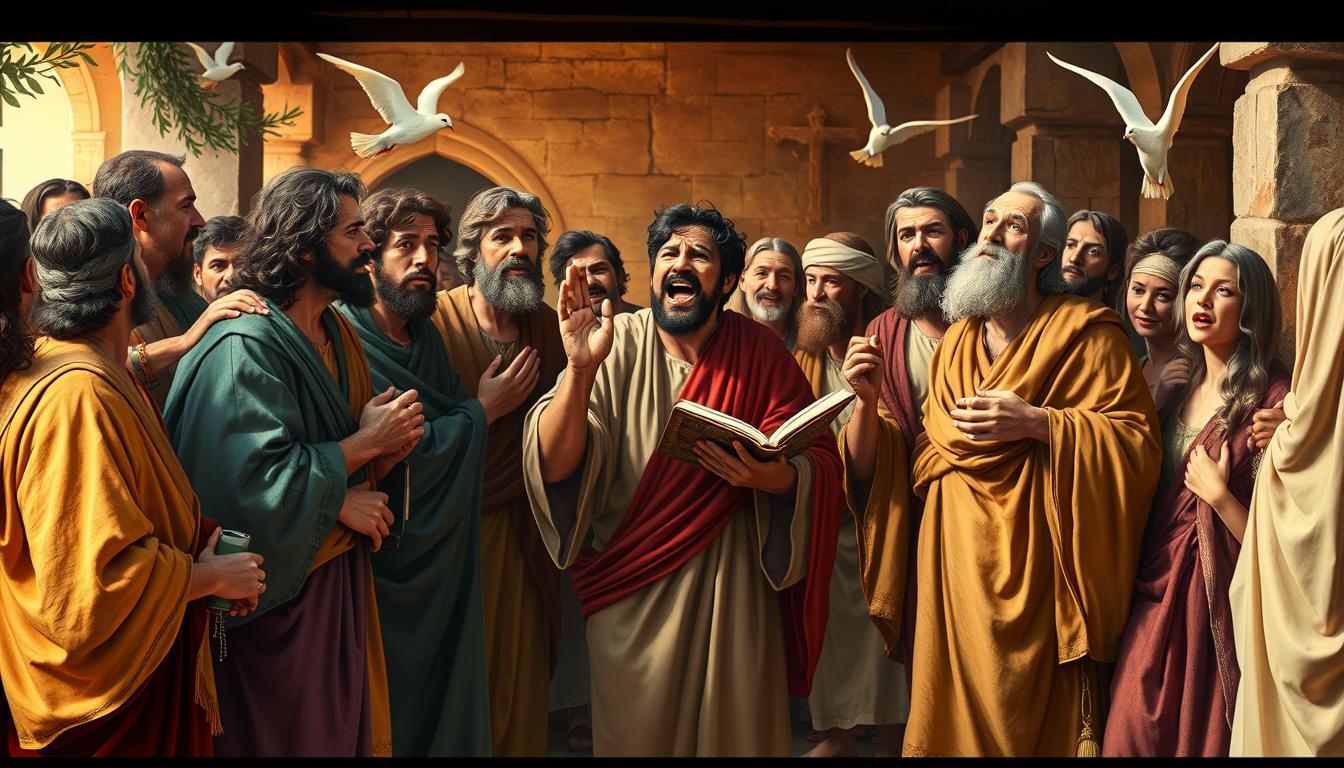The story of Christianity is a mix of faith, history, and culture. It’s about a faith that believes in one God. This faith centers on Jesus Christ’s life and teachings.
His birth, death, and coming back to life are key beliefs for many. These events show his big impact on people. His followers tried to share his message for many years.
We will look at important times in Christianity’s history. From the start to today, each part shows how the faith has grown. Early Christians faced a lot of trouble but kept going, just like Jesus’ first followers.
Thanks to missionaries like Paul, Christianity spread far and wide. It even became accepted in the Roman Empire, thanks to Constantine’s help.
Christianity has had big moments, like making the New Testament. We will explore these moments to see how the faith has shaped today’s world.

Key Takeaways
- Christianity is a monotheistic faith believing in one God.
- Key beliefs include the virgin birth, crucifixion, and resurrection of Jesus Christ.
- The Christian Bible comprises 66 books, split into the Old and New Testaments.
- Early missionaries, particularly Paul, were essential in spreading Christianity.
- Christianity became legal in A.D. 313 under Emperor Constantine.
- The Reformation in the 16th century gave rise to numerous Protestant denominations.
- Christianity remains the world’s largest religion, boasting approximately 2.4 billion followers.
The Origins of Christianity
Christianity started with Jesus Christ. His life and teachings changed many lives. He talked about love, forgiveness, and repentance.
Each gospel tells a part of his story. These stories show the key moments of his ministry.
The Life and Teachings of Jesus Christ
Jesus was a Jewish teacher from the first century. He taught about love and compassion. His parables are still lessons today.
His stories show his miracles and the heart of Christian beliefs. His teachings, like the Sermon on the Mount, have inspired many.
Jesus as a Historical Figure
Many historians say Jesus was real. His life is written in ancient texts. This shows he was important in early Christianity.
Seeing him as a real person helps us understand the faith. It makes us appreciate his teachings more.
The Concept of the Messiah in Christianity
Jesus is seen as the Messiah in Christianity. This means he was the savior promised in the Old Testament. He brought a new covenant of salvation.
This belief is key to Christianity. It shapes its teachings and practices around the world.
The Apostolic Age and Early Church Development
The Apostolic Age was a big change for early Christians after Jesus came back to life. It lasted from about 30 AD to 100 AD. During this time, the first followers of Christ worked hard to share the gospel everywhere. They started a faith tradition that would grow big.
The Role of the Apostles in Spreading the Gospel
The Apostles were Jesus’ closest friends. They were sent to share his teachings. Paul was especially important for his travels and letters. His work helped many people understand Christianity better.
He talked to people who were not Jewish, making Christianity more open. Places like Antioch were key. That’s where the word “Christian” first appeared.
Early Christian Communities and Practices
Early Christian groups started to form. They shared beliefs and practices that made their faith strong. Baptism and the Eucharist were important for their community.
By the 2nd century, churches were growing in Gaul, Latin Africa, and more. The Apostles’ work had spread far. Even though they faced hard times, the church kept growing. Leaders like bishops, presbyters, and deacons helped guide the church.
| Region | Notable Cities | Status by 2nd Century |
|---|---|---|
| Gaul | Lyon, Vienne, Marseille | Established churches |
| Latin Africa | Carthage | Established churches |
| Britain | London | Established churches |
| Spain | Unknown | Emerging communities |
| Roman Germany | Unknown | Emerging communities |
Christianity Under Roman Rule
Christianity’s journey in the Roman Empire was filled with ups and downs. Early years saw a lot of struggles. Followers faced persecution for their beliefs.
This was due to political issues and fear of change. Yet, the faith grew strong, showing its power and appeal.
The Persecution of Christians
In the Roman Empire’s early days, Christians faced persecution. Leaders like Nero blamed them for problems, like the Great Fire of Rome in 64 AD. This led to torture and executions.
Under Emperor Trajan, things got a bit better. Only those who spoke out loudly were targeted. Still, Christianity kept growing. By 300 AD, about 10% of Romans were Christian.

Constantine’s Conversion and the Edict of Milan
Everything changed when Constantine saw a vision before the Battle of Milvian Bridge in 312 AD. This moment was a big turning point. The Edict of Milan in 313 AD made Christianity legal and ended persecution.
This move allowed Christianity to grow and shape Roman society. By the late 300s, it became the official religion under Emperor Theodosius I in 380 AD.
Christianity’s rise shows its strength and ability to grow despite challenges. As it spread, the old ties between the empire and religion changed. A unified faith emerged, overcoming early struggles.
Christian Story: The Evolution of Doctrine
As Christianity spread, the need to formalize its teachings grew. The evolution of doctrine shaped the faith, changing how believers saw core teachings. This led to the New Testament canon, a key moment in Christian history.
The Formation of the New Testament Canon
The New Testament canon has twenty-seven books. These texts came from Jesus’ teachings in Aramaic, translated into Greek. Saint Paul’s writings are the earliest Christian documents, marking important moments in Christian history.
While core texts were accepted, many views on Christ appeared. Some views were seen as heresies and disappeared. Archaeological finds, like the Gnostic Gospels, show the wide range of theological ideas.
The Role of Church Councils
Church councils were key in solving doctrinal disputes. For example, the First Council of Nicaea in AD 325 helped define the Trinity. This council aimed to unite Christian theology amidst different beliefs.
Church councils showed how theology evolved. Nontrinitarianism was a response to Trinitarian views, with groups rejecting the traditional God, Jesus, and Holy Spirit. These debates showed the role of councils in keeping the faith united.
| Aspect | Details |
|---|---|
| Early Texts | Sacred texts like Saint Paul’s writings provide insight into initial Christian thought. |
| Council Significance | Church councils, such as the First Council of Nicaea, were held to address critical theological issues. |
| Canon Formation | The New Testament canon establishes foundational beliefs for Christianity. |
| Diversity of Beliefs | Early Christianity witnessed a variety of perspectives, some deemed heretical. |
| Historical Insights | Archaeological findings contribute to the understanding of Christian doctrine’s evolution. |
The Great Schism and Its Impact on Christianity
The Great Schism happened in 1054. It was a big change in Christian history. It split Eastern Orthodoxy and Western Christianity.
This split came from long-standing disagreements and cultural differences. It has changed Christianity a lot. It also affected religious stories in Europe and beyond.
Eastern and Western Christianity Divergence
The Eastern and Western churches had big disagreements. One issue was the Filioque clause in the Nicene Creed. The West accepted it, but the East did not.
In the 11th century, Rome wanted to be the top church. The East did not agree with this.
The Rise of the Eastern Orthodox Church
After the split, the Eastern Orthodox Church became its own thing. It had its own traditions and ways of worship.
Monasticism grew in the East, starting in Egypt. The East also focused on mysticism and honoring saints through stories.

| Aspect | Eastern Orthodox Church | Western Christianity |
|---|---|---|
| Leadership | Patriarchs, particularly of Constantinople | Papal supremacy |
| Theological Creeds | Acceptance of the first seven ecumenical councils | Filioque clause included in the Nicene Creed |
| Clerical Practices | Clerical marriage allowed | Clerical celibacy enforced |
| Liturgical Focus | Mysticism and tradition | Legalistic and doctrinal emphasis |
| Attempts at Reunion | Council of Lyon (1274), Ferrara-Florence (1439) | Continual assertions of papal authority |
The tension between Eastern Orthodoxy and Western Christianity still affects Christianity today. It shows how differences in beliefs and culture can lead to big splits.
The Age of Reform and Modern Christianity
The Age of Reform was a big change in Christianity. It started in the early 1500s with the Protestant Reformation. This movement questioned the Catholic Church’s power and practices.
People like Martin Luther led the way. They wanted faith to be personal and based on the Bible. This led to many new Christian groups and a diverse faith.
The Protestant Reformation and Its Key Figures
The Protestant Reformation was a series of changes from 1517 to 1600. Important people like Martin Luther, John Calvin, and Henry VIII helped shape this new time. Luther’s 95 Theses questioned the Church’s ways, starting big debates.
John Calvin created a system that many followed. Henry VIII made the Anglican Church, and John Knox started Presbyterianism in Scotland. These actions showed the variety in faith.
Denominations and Diversity in Christianity
The Protestant Reformation led to many Christian groups. This diversity shows the different ways people believe and practice their faith. For example, the Puritans wanted to change the Church of England.
They led to the Dissenters and Nonconformists. Many moved to America, adding to the religious mix. Groups like the Anabaptists also grew into the Mennonites and Hutterites. This shows how Christianity keeps changing and growing.
The Globalization of Christianity
Christianity has grown worldwide, thanks to missions. These efforts have reached places like Africa, Asia, and Latin America. Now, Christianity is growing fast in the global South but is fading in the West.
Missions have been key in spreading the faith. They show how important it is to understand local cultures when sharing Christian teachings.
The Role of Missions in Spreading the Faith
Missions have been crucial in making Christianity global. Missionaries have changed their ways to fit different cultures. They worked on education, healthcare, and justice, helping many communities.
This work helped create a strong faith that blends local traditions and beliefs. It made new followers feel part of something special.
Christianity’s Influence in the Modern World
Today, Christianity still has a big impact. Even though it’s fading in the West, it’s changing the world. Scholars like Philip Jenkins and Mark A. Noll say we need a global theology that includes many voices.
The church must also help persecuted Christians. It should learn from past events, like the Armenian genocide. Christianity must adapt to new challenges while staying true to its teachings.
| Region | Christian Growth | Notable Trends |
|---|---|---|
| Global South | Robust growth | Increasingly vibrant local expressions of faith |
| Western Countries | Decline | Challenges in maintaining traditional practices |
| Asia | Emerging presence | Cultural adaptations enhance local engagement |
| Africa | Rapid increase | Dynamic community involvement and leadership |
Conclusion
The story of Christianity is amazing. It started as a small Jewish group and grew big fast. This shows how strong their faith was and still is.
They told stories to share their beliefs. These stories helped people understand the world and God.
Early Christians believed humans were made like God. This changed how they saw each other. They also worked hard to spread their faith.
They built strong churches and followed leaders like Origen. Origen taught them to think deeply and live well.
The story of Christianity is still alive today. It guides and brings people together. Its teachings give hope and meaning to many.
FAQ
What is the significance of Jesus Christ in Christianity?
Jesus Christ is key in Christianity. His life, teachings, and resurrection started the faith. He taught love, forgiveness, and repentance. He is seen as the Messiah, fulfilling old prophecies.
How did the early Christian community develop?
After Jesus’ resurrection, his Jewish followers spread the gospel. The Apostle Paul was crucial in starting churches. He helped grow faith in the Roman Empire.
What role did persecution play in the growth of Christianity?
Early Christians faced a lot of persecution, especially under Nero. But, the faith grew. It offered hope and community to many.
What was the Edict of Milan, and why is it important?
The Edict of Milan, in 313 AD, allowed Christians to practice freely. It was a big step for Christianity in the Roman Empire.
How was the New Testament canon formed?
The New Testament canon came from debates and church councils. The Council of Nicaea in 325 AD was key. It helped define core Christian beliefs.
What caused the Great Schism?
The Great Schism of 1054 was due to disagreements and cultural differences. It split the Eastern Orthodox and Roman Catholic Churches.
What was the Protestant Reformation?
The Protestant Reformation in the 16th century questioned Catholic authority. Leaders like Martin Luther pushed for personal faith and scripture. This led to new Protestant denominations.
How has Christianity influenced the modern world?
Today, Christianity is a global faith with over two billion followers. It shapes culture, ethics, and social issues. Its teachings address today’s challenges, guiding personal and collective faith.

